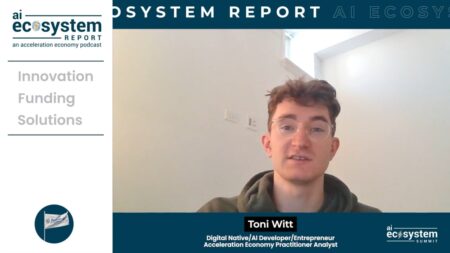Who They Are
While purpose-built clouds exist for, and are widely used in, many industries, only a handful have garnered the most attention, including healthcare, retail, financial services, and manufacturing.
One that you don’t hear too much about is consumer packaged goods, or CPG. This is an industry that, by some accounts, lags behind others in terms of digital transformation and the use of industry clouds. But, at the same time, it’s a larger than $2 trillion market.

With that context, there’s a startup — Aforza — that consumer products companies would do well to investigate. Company leaders have their roots in Salesforce and some of the early, prominent industry cloud players, including life sciences software firm Veeva Systems. Through those experiences, “I learned how powerful an industry cloud can be,” says Aforza co-founder and CEO Dominic Dinardo.
Explaining the company’s positioning, Dinardo says, “We help CPG firms take their products to market: Get products from point A to point B, promote them, distribute them, sell them.”
The company’s software addresses problems unique to consumer goods; officials say it has an important role to play in helping these firms operate efficiently amid today’s economic and business conditions that have exposed the fragility of supply chains.

“We help CPG firms take their products to market: Get products from point A to point B, promote them, distribute them, sell them.”
Dominic Dinardo, co-founder and CEO of Aforza
The company describes its mission as improving the lives of every consumer in the world by helping consumer goods firms to transform their product distribution and customer engagement processes on every channel — online and offline.
The company’s main office is in London; it has $28 million in venture capital funding and 60 employees. It started during the Covid-19 pandemic.
What They Do
The leaders of Aforza started their company to solve three core problems that will sound familiar in many industries but have unique characteristics specific to the consumer goods space.
- The need to capture missed revenue by increasing inventory visibility and identifying real-time opportunities to upsell/cross-sell
- Improving the effectiveness of trade/promotional spend by capturing ROI (return on investment) insights and reacting nimbly to market changes
- Creating visibility from planning to execution to delivery; for example, capturing real-time feedback on results
The company addresses these issues through four applications that make up the Aforza platform:
Aforza Plan
This application is designed to help Aforza customers plan optimal commercial policies; segmenting customers so they can receive targeted pricing and product assortments. It helps customers forecast the ROI of their promotions while also evaluating the performance of those promotions in real-time.
Customers would additionally use this app to plan and optimize routes and visit schedules for their field teams. It helps them launch new products and pricing, as well as establish discounts for new products.
Aforza Visit
Customers use this application to perform stock and merchandise audits while also executing promotion compliance. The application is used to capture customer requests and disputes for rapid resolution. The company says this software will help customers onboard their users faster with a consumer-grade user experience.
Aforza Sell
This application supports an ambitious agenda to boost every sales order across every channel. It speeds up order capture with pre-built order templates and provides access to the latest product materials. It automatically generates invoices, creates receipts, and schedules deliveries.
The application also supports what Aforza positions as a critical differentiator: the ability to accurately capture orders, even when offline — and that typically means from a cell phone because a field employee lacks internet connectivity. A common scenario where this can happen is that of an individual visiting a beverage retail customer and entering a walk-in freezer where there is no internet access. The software can capture and execute transactions — pricing, bundles, discounts — that are “penny perfect,” Dinardo says, and the local version of the app can sync with a server when the internet connection is re-established.
Aforza Deliver
This app is used to load delivery vans optimally and accurately while providing real-time inventory visibility. It collects and manages cash payments, and it generates invoices, in-store. Intelligent routing capabilities enable employees to spend more time in-store, while the app also streamlines management of incoming empty containers.

Trusted Platforms
Aforza’s applications are built on and tightly integrated with Salesforce CRM (customer relationship management) software and Google Cloud services. As previously noted, Dinardo has a long history with Salesforce — he worked there in the cloud software giant’s earliest days. They compared and tested various cloud platforms before settling on Google as the best fit for their artificial intelligence-centric platform and its performance/data management requirements, Dinardo says.
Today, Aforza is primarily selling its software directly to customers, though there are implementation partners — including BearingPoint, CapGemini, and Deloitte — involved in many customer engagements and it’s looking to expand its partner ecosystem. “We need partners to be experts on Aforza, consumer goods, and Salesforce,” he says. “There’s a lot to know about pricing, promotions, and so on.”
Who They’ve Impacted
Aforza software has proof points in solid customer successes.
One such example is Distell, a South African producer and marketer of wines, spirits, ciders, and other ready-to-drink (RTD) beverages.

By using Aforza, Distell was able to conduct end-to-end promotion management, through to order capture, for the first time, Dinardo says, and has significantly increased its average order size.
Distell sales reps are using the above-mentioned mobile functionality to execute transactions on-site with, for example, a liquor store owner. The sales rep can gain instant access to the store’s credit rating, discount rates, and more, and is therefore able to cross-sell, unlock promotions, and so forth. “These things like a credit check, cross-selling, and use of promotions save administration and mistakes, and they didn’t happen before,” Dinardo says.
With a live view of available stock, reps can upsell and cross-sell when there is a stockout.
The Future and Closing Thoughts
Dinardo says the company’s platform is on track to have handled $1 billion in transactions for its consumer goods customers by the end of January, which is the end of Aforza’s fiscal year. That figure signals a high level of trust and confidence in the platform. From a competitive standpoint, Aforza must work to differentiate between industry cloud giants that compete in a wide range of industries and lesser-known, consumer goods-focused industry cloud providers. That’s not an unusual challenge for a software startup; the company will be relying on its deep well of industry cloud expertise to drive that differentiation and win over big customers looking to move forward with digital transformations.
For more exclusive coverage of innovative cloud companies, check out Cloud Wars Horizon here:








